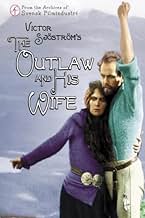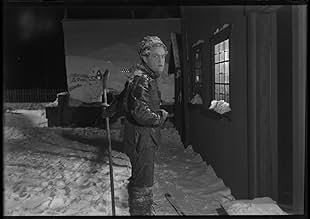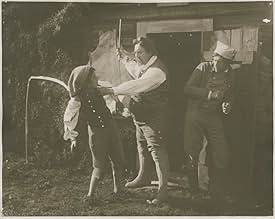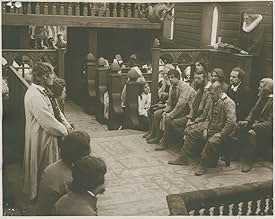IMDb RATING
7.1/10
2.2K
YOUR RATING
Ejvind and his family are in need of food. So Ejvind seeks help from the rich priest next door. He refuses to help. Ejvind then steals a sheep from the priest, he is caught. But he escapes f... Read allEjvind and his family are in need of food. So Ejvind seeks help from the rich priest next door. He refuses to help. Ejvind then steals a sheep from the priest, he is caught. But he escapes from prison, and becomes an outlaw.Ejvind and his family are in need of food. So Ejvind seeks help from the rich priest next door. He refuses to help. Ejvind then steals a sheep from the priest, he is caught. But he escapes from prison, and becomes an outlaw.
- Director
- Writers
- Stars
Walerie Alexandrow-Höök
- Berg-Ejvinds och Hallas dotter Tota
- (as Walerie Alexandrow)
- Director
- Writers
- All cast & crew
- Production, box office & more at IMDbPro
Featured reviews
(1918) The Outlaw and His Wife/ Berg-Ejvind och hans hustru
SILENT DRAMA
Co-written, directed and starring Victor Sjöström, he plays an unknown drifter, Kari (Victor Sjöström) looking for work and ends up working at a farm, owned by Halla (Edith Erastoff). And as they begin to fall in love, it is then his past begins to catch up with him that his name is not Kari, but is really Eyvind suspected of escaping from prison. Adapted from the play "Eyvind of the Hills" by Jóhann Sigurjónsson.
A silent Swedish film that is reminiscent of a serious love story that has a complicated situation, that can be used as a basis for movies that come after it.
Co-written, directed and starring Victor Sjöström, he plays an unknown drifter, Kari (Victor Sjöström) looking for work and ends up working at a farm, owned by Halla (Edith Erastoff). And as they begin to fall in love, it is then his past begins to catch up with him that his name is not Kari, but is really Eyvind suspected of escaping from prison. Adapted from the play "Eyvind of the Hills" by Jóhann Sigurjónsson.
A silent Swedish film that is reminiscent of a serious love story that has a complicated situation, that can be used as a basis for movies that come after it.
Natural surroundings heighten a movie director's ability to examine his characters' identities. The first film in cinema to introduce soaring landscapes and weather elements for the purpose of exploring the actors' interior personalities is Swedish director Victor Sjostrom's January 1918 "The Outlaw and His Wife."
Based on the true story of a mid-1700 criminal escaping incarceration with his wife into the mountains of Iceland, "The Outlaw and His Wife" uses the stunning scenery of northern Sweden to reflect nature's impact on human behavior, especially displayed in the second half of the movie.
Sjostrom and Edith Erastoff appeared in the director's earlier "The Man There Was," and began a relationship despite Erastoff marriage status. In fact, Edith was pregnant with Sjostrom's child when filming "The Outlaw and His Wife." She delivered a girl, Guje Lagerwall, who lived to be 100, soon after the January premier. Sjostrom and Erastoff eventually married in 1922 after she secured a divorce from her first husband.
Sjostrom worked well with cinematographer Julius Jaenzon, who lends a surreal tone to this highly visual film. He uses the sun frequently to backlight the actors, and often overexposes the film to portray them in a fairytale-like glow. Jaenzon also silhouettes his on-camera personalities against huge backdrops to emphasize how puny people and their problems are in relation to the overall scheme of God's great work in presenting earth's majesty.
Besides man's co-existing with a sometimes turbulent nature, Sjostrom shows the psychological mechanics within a human relationship, especially reflected memorably in the sequence where Erastoff throws the couple's baby over the cliff. Such stress in hiding from the law in an unforgiving environment casts a light on the breaking point of the human condition in such circumstances.
Today's directors such as Terrance Malick, known for his photographic expertise, studied "The Outlaw and His Wife" for its natural elements incorporated into their characters' behavior and plot motivations. Sjostrom's film played a huge influence on later visually-stunning motion pictures using nature's varied landscapes.
Based on the true story of a mid-1700 criminal escaping incarceration with his wife into the mountains of Iceland, "The Outlaw and His Wife" uses the stunning scenery of northern Sweden to reflect nature's impact on human behavior, especially displayed in the second half of the movie.
Sjostrom and Edith Erastoff appeared in the director's earlier "The Man There Was," and began a relationship despite Erastoff marriage status. In fact, Edith was pregnant with Sjostrom's child when filming "The Outlaw and His Wife." She delivered a girl, Guje Lagerwall, who lived to be 100, soon after the January premier. Sjostrom and Erastoff eventually married in 1922 after she secured a divorce from her first husband.
Sjostrom worked well with cinematographer Julius Jaenzon, who lends a surreal tone to this highly visual film. He uses the sun frequently to backlight the actors, and often overexposes the film to portray them in a fairytale-like glow. Jaenzon also silhouettes his on-camera personalities against huge backdrops to emphasize how puny people and their problems are in relation to the overall scheme of God's great work in presenting earth's majesty.
Besides man's co-existing with a sometimes turbulent nature, Sjostrom shows the psychological mechanics within a human relationship, especially reflected memorably in the sequence where Erastoff throws the couple's baby over the cliff. Such stress in hiding from the law in an unforgiving environment casts a light on the breaking point of the human condition in such circumstances.
Today's directors such as Terrance Malick, known for his photographic expertise, studied "The Outlaw and His Wife" for its natural elements incorporated into their characters' behavior and plot motivations. Sjostrom's film played a huge influence on later visually-stunning motion pictures using nature's varied landscapes.
I have waited for years to see this film and finally caught it on Youtube - in excellent condition. It was definitely worth the wait! The film was made in 1918, a time when most cinema consisted of small segments of celluloid patched together with the standard melodramatic or comedic situations, clumsily filmed indoors on make-shift sets. This is absolutely nothing of the kind although it took Hollywood what seemed an eternity to figure out that a movie could, indeed, be shot out in the open with great success. Several reviewers have mentioned some sort of connection with early Westerns made by directors of little artistic talent and less scope. Actually, this film has nothing whatsoever to deal with standard plots with famous actors. The plot is extremely simple, as it should be in this case, and all - virtually all - of the over-the-board overacting and the theatrical motions and over-emotions suppressed, with natural gestures replacing them in natural settings...and what beautiful settings they are! No, there aren't any tied-together happy ends around and little to titillate the audience, villains with mustaches or any of the standard American clichés here. The film is Scandinavian, filmed and acted by Scandinavians, shot in North Sweden far, far away from the ole corral. I don't know how well the director, Victor Sjostrom, was acquainted with American cinema at the time - there wasn't really much of anything of much value going except from Griffith and one or two others, but the film borrows nothing and invents everything for its own uses. The cinema up there created a universe of its own, albeit a harsh one. Bergman would follow fifty years later. This was a welcome hour or so spent in the company of people who made some astoundingly good films and this is certainly one of them.
Curtis Stotlar
Curtis Stotlar
It is a truism that Victor Sjostrom's films dramatise the conflict between nature and society, but his treatment is less simplistic than might be first apparent. For instance, society in 'The Outlaw and his Wife' is ruled by a brutal, land-grabbing Bailiff who whips servants for losing a sheep; but it is also a place rich in pageantry, costume and rite, where communities can express themselves.
Similarly, nature might be a site of freedom for social outsiders, a sustaining idyll for lovers, and an awe-inspiring backdrop, but it also overflows in the lonely vagrant who comes close to rape, or the cliff and snows that can kill.
Throughout Sjostrom shifts impressively between registers - nature as both real presence and symbolic backdrop; plot as both social depiction and spiritual journey - while retaining familiar action pleasures.
Similarly, nature might be a site of freedom for social outsiders, a sustaining idyll for lovers, and an awe-inspiring backdrop, but it also overflows in the lonely vagrant who comes close to rape, or the cliff and snows that can kill.
Throughout Sjostrom shifts impressively between registers - nature as both real presence and symbolic backdrop; plot as both social depiction and spiritual journey - while retaining familiar action pleasures.
The Outlaw and His Wife (1918) directed by Victor Sjöström is yet another impressive production in early cinema history.
The story revolves around a stranger who comes to work at a widow's (Halla's) farm. Halla and the stranger fall in love, but when he is revealed as Eyvind, an escaped thief forced into crime by his family's starvation, they flee and become two of the many outlaws of Iceland's mountains.
Victor Sjöström's early films are impressive in their own right. In The Outlaw and his Wife, he almost uses nature as a character, pressuring the humans of the film to the very brink of - and beyond - their moral values. This works effectively in driving a more abstract point of the film; what is one willing to do in order to ensure one's own safety and survival, and yet further abstract; what is good and evil as philosophical constructs?
It is similarly highly recommended for film buffs and those interested in cinema history just like Sjöström's earlier film Terje Vigen (1917), although The Outlaw and his Wife is not as contemporary as Terje Vigen. Lacking a score and being twice as long, it does not feel as focused although it definitely is more epic in its scale and production.
The story revolves around a stranger who comes to work at a widow's (Halla's) farm. Halla and the stranger fall in love, but when he is revealed as Eyvind, an escaped thief forced into crime by his family's starvation, they flee and become two of the many outlaws of Iceland's mountains.
Victor Sjöström's early films are impressive in their own right. In The Outlaw and his Wife, he almost uses nature as a character, pressuring the humans of the film to the very brink of - and beyond - their moral values. This works effectively in driving a more abstract point of the film; what is one willing to do in order to ensure one's own safety and survival, and yet further abstract; what is good and evil as philosophical constructs?
It is similarly highly recommended for film buffs and those interested in cinema history just like Sjöström's earlier film Terje Vigen (1917), although The Outlaw and his Wife is not as contemporary as Terje Vigen. Lacking a score and being twice as long, it does not feel as focused although it definitely is more epic in its scale and production.
Did you know
- TriviaBased on the story of Eyvindur of the Mountains (1714-1783), an outlaw in Iceland who fled into the mountains with his wife around 1760 and remained there for twenty years.
- Alternate versionsTurner Classic Movies has shown on TV a restored version copyrighted in 1968 by Svenska Filminstitutet (The Swedish Film Instute). The restoration credits are in Swedish, but some of the original cast and crew credits are in English. All intertitles are in English and the film runs 73 minutes.
- ConnectionsFeatured in Victor Sjöström - ett porträtt av Gösta Werner (1981)
- SoundtracksKung Kristian II, op. 27
Composed by Jean Sibelius (1898)
- How long is The Outlaw and His Wife?Powered by Alexa
Details
- Release date
- Country of origin
- Official site
- Language
- Also known as
- The Outlaw and His Wife
- Filming locations
- Nuolja, Abisko, Sweden(mountain scenery)
- Production company
- See more company credits at IMDbPro
Box office
- Budget
- SEK 100,000 (estimated)
- Runtime1 hour 12 minutes
- Sound mix
- Aspect ratio
- 1.33 : 1
Contribute to this page
Suggest an edit or add missing content































